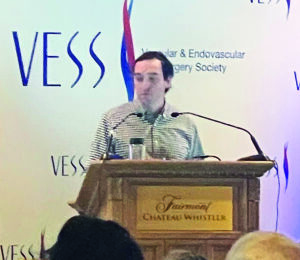
A novel, order-initiated workflow facilitated by the electronic health record (EHR) has been shown to improve timeliness of care for vascular surgery patients, decreasing time to operation and working to standardize and automate the consultation process.
Presented at the 2023 winter annual meeting of the Vascular and Endovascular Surgery Society (VESS) in Whistler, British Columbia (Feb. 23–26), by University of Colorado general surgery resident John Iguidbashian, MD, senior author Jeniann Yi, MD, spoke to Vascular Specialist about why streamlining consultation operations is paramount for the “acute and urgent” cases vascular healthcare professionals often handle.
Implemented at a single institution, the team’s order-initiated workflow automated notifications to providers of consult requests, communication of patient data, patient additions to consultants’ lists, and tracked consult completion. The investigators subsequently compared consultation timelines pre- and post-implementation.
When prompted on their reasoning in evaluating this process, Yi, an assistant professor of surgery at the University of Colorado in Aurora, Colorado, fleshed out the prevalent “issues” they had been encountering with the system, stating that “there was no clear understanding” in the process. She noted a criticism they had encountered which suggested that the system may remove the human element of providing patient information. However, Yi countered this by affirming that, particularly in critically ill patients, if the complete order was initiated and the workflow subsequently expedited, then healthcare professionals are able to trigger those essential, in-person conversations faster. “It removes a lot of steps and mindless work from of the process,” Yi said.
The authors evaluated 278 inpatient and emergency department vascular surgery consultations (158 pre-implementation, 120 post-implementation); 41 and 38 consults required surgery pre- and post-implementation, respectively. Among their results, viewable consult notes were available 31.77 minutes earlier than pre-implementation, while attending attestations outlining final treatment plans were added 205.65 minutes sooner post-implementation.
Yi asserts that by using their novel workflow they were able to more easily track recommendations so that actions could be initiated for patient recommendations sooner, and potentially expedite them to lower levels.
Although their results show positive evidence to support the EHR—also known as the electronic medical record (EMR)—as a tool, practitioners expressed “mixed feelings” toward it, Yi explained. When asked about the audiences’ reception of their presentation at VESS, however, Yi stated that discussions centered around how the existing process can be “adapted” to solve “conflicts within existing workflows” as to not pile on additional “[burdensome]” admin.
Emphasizing an area in which their research proves essential, Yi observed that the vascular subspecialty—which frequently includes acute care surgery—is a key area where streamlined workflow processes would benefit most: “Time matters, especially in human intervention—the sooner they receive treatment, the better their outcomes are. To save time is the goal and at the heart of it, it’s about being able to provide prompt treatment for these patients in need of urgent care.”












